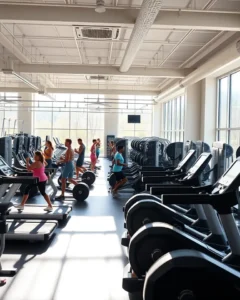Fitness influencer Ashton Hall has recently gained viral attention for his detailed morning and now night routines, sparking debate about the effectiveness and safety of his methods. His night routine, which includes ice baths, nose strips, and mouth taping, has drawn both admiration and skepticism. Are these practices genuinely beneficial, or are they simply extreme measures with potential risks?
Who is Ashton Hall?
Ashton Hall, born on October 24, 1995, is a 29-year-old American fitness trainer and social media personality. He is known for posting workout content and insights into his life as an online coach. Hall has amassed a large following across various platforms, including over 9 million on Instagram, and millions more on TikTok and YouTube. He is also a former college football running back. Hall’s fitness journey began after a period of depression and weight gain following his athletic career. Inspired by friends, he dedicated himself to exercise, transforming his physique and launching his career as a fitness influencer. Hall began his fitness career in 2019 and, in 2020, started focusing on building his online presence, quickly gaining popularity for his fitness regimens and inspirational content.
Ashton Hall’s Night Routine: A Breakdown
Hall’s night routine is designed to promote relaxation and prepare him for an early rise at 3:50 AM. Here’s a detailed look at the components:
- 5:02 PM – 5:24 PM: Cold Bath: Hall takes a cold bath, adding ice cubes and bath salts to maximize the benefits.
- 5:30 PM – 5:52 PM: Regular Bath: He follows the ice bath with a regular bath, using aromatic candles and a bath bomb. He also uses this time to eat dinner.
- 6:20 PM – 6:35 PM: Banana Peel Facial and Oral Care: Hall eats a banana and rubs the peel on his face, followed by rinsing his mouth and brushing his teeth.
- 7:30 PM: Bedtime: Hall reads the bible, applies nose strips and mouth tape, and goes to sleep.
Ice Baths: Benefits, Risks, and Expert Opinions
Ice baths, or cold water immersion (CWI), involve submerging the body in ice water for a short period, typically between 10 to 15 minutes at a temperature of 10°C to 15°C.
Potential Benefits:
- Reduced Muscle Soreness: Ice baths can help decrease delayed onset muscle soreness after intense exercise by constricting blood vessels and reducing inflammation and swelling.
- Improved Muscle Recovery: Cold water immersion may positively influence muscular power performance and reduce soreness after high-intensity exercise.
- Boosted Mood and Alertness: Ice baths can increase levels of neurotransmitters like dopamine and serotonin, potentially improving mood and mental state.
- Enhanced Circulation: Cold exposure causes blood vessels to constrict, followed by rapid dilation as the body warms up, improving circulation and delivering oxygen and nutrients to tissues.
- Improved Sleep: Some athletes report improved mental state and better sleep patterns after taking post-exercise ice baths.
- Increased Immune Function: Regular cold exposure may strengthen the immune system by increasing the number of white blood cells.
- Reduced Inflammation: Cold water constricts blood vessels, which can help with swelling related to inflammation.
Risks and Considerations:
- Hypothermia: Prolonged exposure to cold water can lower core body temperature, leading to shivering, confusion, and unconsciousness.
- Cardiovascular Stress: Cold water causes blood vessels to constrict, raising blood pressure and forcing the heart to work harder, which can be dangerous for people with heart conditions or hypertension.
- Cold Shock: Sudden immersion in cold water can cause a rapid increase in heart rate, blood pressure, and breathing, potentially leading to panic and drowning.
- Nerve and Skin Damage: Repeated or long exposure to very cold water may result in ice burn or frostbite, damaging skin tissue and nerves.
- Drowning: The cold shock response can impair a person’s ability to think and swim, increasing the risk of drowning.
- Cold Urticaria: This skin condition causes itchy welts when the skin touches something cold, like ice water, and can also cause faintness and swelling of the throat or lips.
Expert Opinions:
- While some studies suggest improvements in muscle recovery and performance, others refute these findings.
- Some experts suggest that the timing and intensity of cold exposure may need a more personalized approach to maximize benefits, especially for women due to hormonal fluctuations.
- It’s essential to approach ice baths with caution and informed awareness, prioritizing well-being and consulting healthcare professionals.
- The scientific evidence surrounding ice baths remains inconclusive, and more research is needed to elucidate the true effects of cold-water immersion on the body.
Nose Strips: Benefits, Risks, and Expert Opinions
Nasal strips are adhesive strips placed on the nose to widen nostrils and increase airflow.
Potential Benefits:
- Reduced Snoring: Nasal strips can reduce snoring by decreasing air resistance in the nasal passages.
- Improved Breathing: By widening the nostrils, nasal strips can make it easier to breathe through the nose, especially for those with nasal congestion or a deviated septum.
- Alleviated Nasal Congestion: Nasal strips can alleviate nasal congestion and relieve nasal snoring.
- Enhanced Physical Performance: Athletes may find nasal strips beneficial for enhanced physical performance due to improved oxygen intake.
Risks and Considerations:
- Skin Irritation: The adhesive in nasal strips can cause skin irritation, redness, or itching beneath the strip.
- Ineffective for Complex Conditions: Nasal strips may not be effective for snoring caused by complex underlying issues like obstructive sleep apnea.
- Not a Substitute for Medical Advice: Nasal strips are not a substitute for professional medical advice, and individuals with chronic or severe nasal congestion should consult a healthcare provider.
- Limited Daytime Use: Nasal strips are impractical for daytime use.
- Challenge for Oily Skin: People with oily skin may find it challenging to keep nasal strips in place.
Expert Opinions:
- Studies show that nasal strips can increase nasal cavity volume and improve nasal inspiratory flow, helping to breathe more easily.
- The effectiveness of nasal strips depends on individual nasal structure and the root cause of breathing issues.
- Nasal strips may offer limited relief for those with snoring issues unrelated to nasal blockage, like sleep apnea.
Mouth Taping: Benefits, Risks, and Expert Opinions
Mouth taping involves sealing the lips shut with tape while sleeping to encourage nasal breathing.
Potential Benefits:
- Reduced Snoring: Mouth taping may help reduce snoring, especially in people with positional sleep apnea.
- Improved Sleep Quality: By encouraging nose breathing, mouth taping may improve sleep quality.
- Better Oral Health: Mouth taping can prevent dry mouth, which can lead to cavities and bad breath.
- Filtered Air: Nose breathing filters out allergens, dust, and bacteria.
- Humidified Air: Nose breathing delivers warmer, more humid air to the lungs.
- Increased Lung Volume: Nose breathing adds resistance that benefits lung volume.
Risks and Considerations:
- Difficulty Breathing: Mouth taping can cause difficulty breathing, especially for those with nasal obstructions or allergies.
- Skin Irritation: The tape can cause skin irritation or allergic reactions.
- Anxiety: Some people may feel anxious or uncomfortable with their mouth taped shut.
- Impaired Breathing: Taping your mouth shut while you’re sleeping could put you at risk for impaired breathing, disrupted sleep, and even reduced oxygen levels.
- Aspiration: If you vomit or have acid reflux when your mouth is taped, the stomach contents could go into your lungs, leading to serious consequences such as pneumonia.
- Not a Safe Way to Improve Nasal Breathing: There is not enough scientific evidence to support benefits from mouth taping, and it can be dangerous.
Expert Opinions:
- Some doctors are calling for mouth taping to come with federal warnings about potential health risks.
- It’s crucial to have a sleep specialist evaluate nighttime mouth breathing or snoring to treat these conditions medically rather than trying to alleviate symptoms with mouth taping.
- Mouth taping is not recommended because there’s not enough scientific evidence to support the anecdotal benefits behind this viral trend.
The Verdict: Extreme or Effective?
Ashton Hall’s night routine incorporates several practices with potential benefits, but also significant risks. While ice baths may aid muscle recovery and improve mood, they can also lead to hypothermia and cardiovascular stress. Nose strips can improve breathing and reduce snoring, but may cause skin irritation. Mouth taping may encourage nasal breathing, but poses risks such as difficulty breathing and anxiety.
Before adopting such an extreme routine, it’s crucial to consult with healthcare professionals to assess individual health conditions and weigh the potential benefits against the risks. What works for a fitness influencer may not be suitable or safe for everyone.







